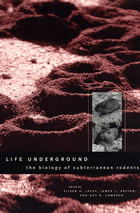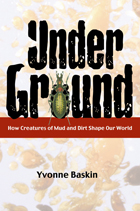2 books about Burrowing animals

Life Underground
The Biology of Subterranean Rodents
Edited by Eileen A. Lacey, James L. Patton, and Guy N. Cameron
University of Chicago Press, 2000
Many mammals like to dig in the dirt, but few call it home. Those that do, such as mole-rats, zokors, and tuco-tucos, have developed novel adaptations to their subterranean life, including bones and muscles modified for efficient digging and ways to "see" underground without using their eyes. These unusual traits, adopted independently by unrelated groups around the world, also make subterranean rodents fascinating subjects for biologists.
Life Underground provides the first comprehensive review of the biology of subterranean rodents. Arranged by topic rather than by taxon to facilitate cross-species comparisons, chapters cover such subjects as morphology, physiology, social behavior, genetic variation, and evolutionary diversification. Two main questions run throughout the book. First, to what extent has subterranean life shaped the biology of these animals, leading to similar adaptations among otherwise dissimilar species? Second, how have the distinct evolutionary histories of these groups led to different solutions to the challenges posed by life underground?
Life Underground provides the first comprehensive review of the biology of subterranean rodents. Arranged by topic rather than by taxon to facilitate cross-species comparisons, chapters cover such subjects as morphology, physiology, social behavior, genetic variation, and evolutionary diversification. Two main questions run throughout the book. First, to what extent has subterranean life shaped the biology of these animals, leading to similar adaptations among otherwise dissimilar species? Second, how have the distinct evolutionary histories of these groups led to different solutions to the challenges posed by life underground?
[more]

Under Ground
How Creatures of Mud and Dirt Shape Our World
Yvonne Baskin
Island Press, 2005
Let's get dirty. In childhood, the back yard, the flowerbed, the beach, the mucky place where land slips into puddles, lakes, and streams are infinitely fascinating. It is a mistake to leave that "childish" fascination with mud and dirt behind. The soils of the Earth, whether underneath our feet or pressurized beneath tons of ocean water, hold life in abundance. A handful of garden dirt may harbor more species than the entire aboveground Amazon.
The robotic rovers Spirit and Opportunity made headlines as they scraped their way across the Martian landscape, searching for signs of life. But while our eyes have been turned toward the skies, teeming beneath us and largely unexplored lies what Science magazine recently called the true "final frontier." A growing array of scientists is exploring life in soils and sediments, uncovering a living world literally alien to our own senses--and yet one whose integrity turns out to be crucial to life above ground.
Yvonne Baskin takes the reader from the polar desert of Antarctica to the coastal rain forests of Canada, from the rangelands of Yellowstone National Park to the vanishing wetlands of the Mississippi River basin, from Dutch pastures to English sounds, and beyond. She introduces exotic creatures--from bacteria and fungi to microscopic nematode worms, springtails, and mud shrimp--and shows us what scientists are learning about their contribution to sustaining a green and healthy world above ground. She also explores the alarming ways in which air pollution, trawl fishing, timber cutting, introductions of invasive species, wetland destruction, and the like threaten this underground diversity and how their loss, in turn, affects our own well being.
Two-thirds of the world's biological diversity exists in soils and underwater sediments, and yet most of us remain unaware of these tiny multitudes that run the planet beneath the scenes. In Under Ground, Baskin reveals the startling ways in which that life, whether in our own back yards, in fields and forests, or in the furthest reaches of the Earth, is more numerous, significant, and fascinating than we once imagined.
The robotic rovers Spirit and Opportunity made headlines as they scraped their way across the Martian landscape, searching for signs of life. But while our eyes have been turned toward the skies, teeming beneath us and largely unexplored lies what Science magazine recently called the true "final frontier." A growing array of scientists is exploring life in soils and sediments, uncovering a living world literally alien to our own senses--and yet one whose integrity turns out to be crucial to life above ground.
Yvonne Baskin takes the reader from the polar desert of Antarctica to the coastal rain forests of Canada, from the rangelands of Yellowstone National Park to the vanishing wetlands of the Mississippi River basin, from Dutch pastures to English sounds, and beyond. She introduces exotic creatures--from bacteria and fungi to microscopic nematode worms, springtails, and mud shrimp--and shows us what scientists are learning about their contribution to sustaining a green and healthy world above ground. She also explores the alarming ways in which air pollution, trawl fishing, timber cutting, introductions of invasive species, wetland destruction, and the like threaten this underground diversity and how their loss, in turn, affects our own well being.
Two-thirds of the world's biological diversity exists in soils and underwater sediments, and yet most of us remain unaware of these tiny multitudes that run the planet beneath the scenes. In Under Ground, Baskin reveals the startling ways in which that life, whether in our own back yards, in fields and forests, or in the furthest reaches of the Earth, is more numerous, significant, and fascinating than we once imagined.
[more]
READERS
Browse our collection.
PUBLISHERS
See BiblioVault's publisher services.
STUDENT SERVICES
Files for college accessibility offices.
UChicago Accessibility Resources
home | accessibility | search | about | contact us
BiblioVault ® 2001 - 2024
The University of Chicago Press









